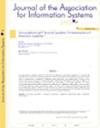渗透还是略读?考虑非对称横向网络效应的软件平台定价策略
IF 5.5
3区 管理学
Q1 COMPUTER SCIENCE, INFORMATION SYSTEMS
引用次数: 3
摘要
考虑一个以软件开发者为一方,软件用户为另一方的双边软件平台,我们研究了该平台应该采用渗透定价策略还是开发者端撇脂定价策略。我们提出了一个考虑不对称横向网络效应的两周期分析模型来分析平台的最优定价策略。我们的分析表明,如果用户与开发者之间的网络效应强大,平台应该采用渗透定价策略,否则则采用撇脂定价策略。如果平台不向用户收取访问费用,则平台应考虑仅在第一阶段补贴开发者的访问费用。然而,当平台向用户收取访问费用时,补贴开发者在这两个时期的访问对平台来说是可行的。如果用户对开发者的网络效应较弱,向软件用户收取使用费会激励平台在第一阶段补贴开发者。最后,本研究揭示了两个周期内向开发者收取或补贴的最优接入费用由几个关键因素决定:开发者对平台收益的基本预期(乐观或悲观)、横向网络效应的强度、两个周期的长度以及向用户收取的接入费用。本文章由计算机程序翻译,如有差异,请以英文原文为准。
Penetration or Skimming? Pricing Strategies for Software Platforms Considering Asymmetric Cross-Side Network Effects
Considering a two-sided software platform with software developers on one side and software users on the other, we study whether the platform should adopt a penetration pricing strategy or skimming pricing strategy on the developer side. We propose a two-period analytical model with asymmetric cross-side network effects to analyze the platform’s optimal pricing strategy. Our analysis reveals that the platform should adopt a penetration pricing strategy if the user-to-developer network effect is strong and a skimming pricing strategy otherwise. If the platform does not charge users an access fee, the platform should consider subsidizing developers’ access in the first period only. However, when the platform charges users an access fee, subsidizing developers’ access in both periods can be viable for the platform. Charging the software user an access fee incentivizes the platform to subsidize developers in the first period if the user-to-developer network effect is weak. Finally, this study reveals that the optimal access fee charged or subsidy provided to developers in the two periods is determined by several key factors: developers’ basic expectations about the revenue to be gained from the platform (optimistic or pessimistic), intensities of cross-side network effects, the lengths of the two periods, and the access fee charged to users.
求助全文
通过发布文献求助,成功后即可免费获取论文全文。
去求助
来源期刊

Journal of the Association for Information Systems
工程技术-计算机:信息系统
CiteScore
11.20
自引率
5.20%
发文量
33
审稿时长
>12 weeks
期刊介绍:
The Journal of the Association for Information Systems (JAIS), the flagship journal of the Association for Information Systems, publishes the highest quality scholarship in the field of information systems. It is inclusive in topics, level and unit of analysis, theory, method and philosophical and research approach, reflecting all aspects of Information Systems globally. The Journal promotes innovative, interesting and rigorously developed conceptual and empirical contributions and encourages theory based multi- or inter-disciplinary research.
 求助内容:
求助内容: 应助结果提醒方式:
应助结果提醒方式:


